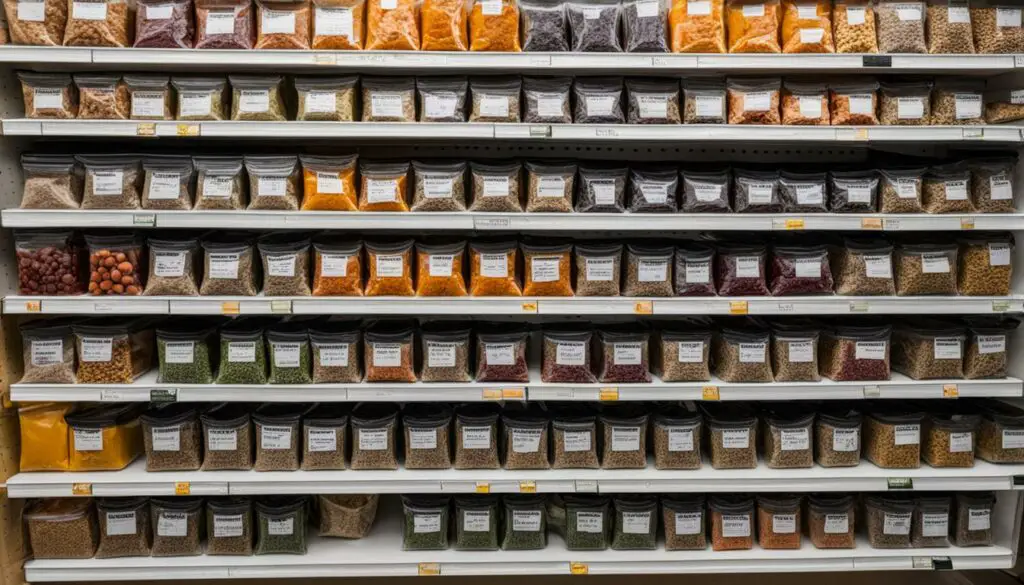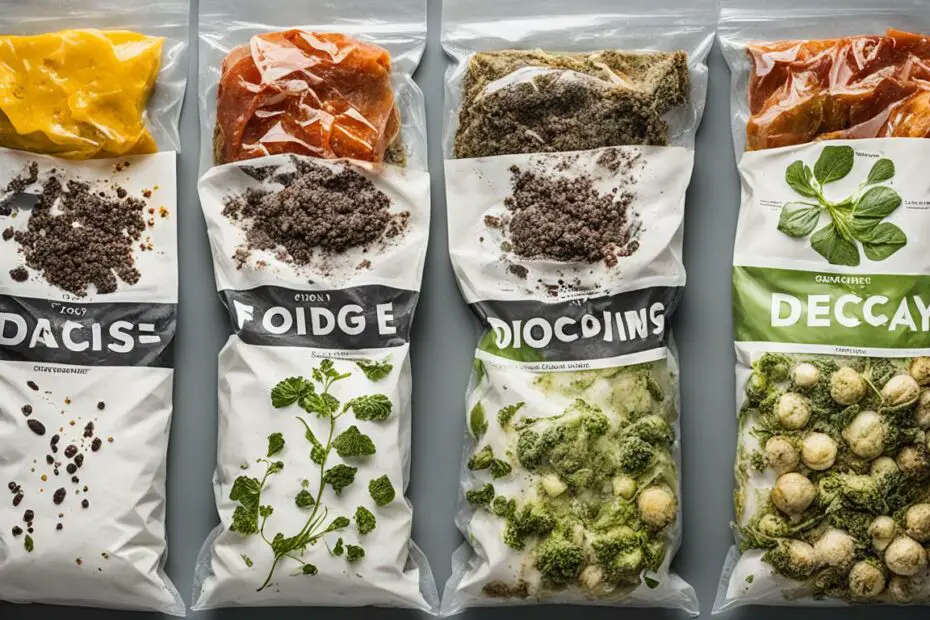Did you know that vacuum sealing can increase the shelf life of food by up to 5 times? It’s true! Vacuum sealed bags have become a game-changer for extending food storage and reducing waste. By removing air from the packaging, vacuum sealing prevents the growth of bacteria, reduces oxidation, and minimizes the risk of freezer burn. In this article, we will delve into the science and benefits of vacuum sealing, compare the shelf lives of vacuum sealed and conventional methods, discuss how long vacuum sealed bags last, provide best practices for storage, and share tips and tricks for extending food storage with vacuum sealing.
The Science of Vacuum Sealing for Food Preservation
Understanding the science behind vacuum sealing is essential for maximizing its benefits. The process involves removing air from the packaging, creating a vacuum and sealing the bag. This technique reduces oxygen levels, which inhibits the growth of bacteria and slows down the spoilage process.
Understanding the Vacuum Sealing Process
Vacuum sealing is a method of packaging food that removes air from the bag or container. This is typically done using a vacuum sealer machine. The machine sucks out the air, creating a vacuum inside the package. Once the air is removed, the bag is sealed, creating a tight barrier between the food and the outside environment.
Benefits of Reduced Oxygen Packaging
Reduced oxygen packaging, as achieved through vacuum sealing, offers various benefits for food preservation. By minimizing oxygen exposure, vacuum sealing helps preserve the flavor, texture, and nutritional value of the food. It also prevents the occurrence of freezer burn, which can negatively affect the quality of frozen food. Additionally, vacuum sealing reduces the need for preservatives, as bacteria growth is inhibited due to the lack of oxygen.
Historical Evolution of Vacuum Sealing Technology
The history of vacuum sealing technology dates back to the 1950s with the invention of the Cryovac vacuum packaging process for whole turkeys. This breakthrough allowed food to be preserved for longer periods by removing the air from the packaging. Since then, vacuum sealing technology has evolved significantly, with advancements in machinery, materials, and techniques. These advancements have resulted in improved food preservation and storage, making vacuum sealing a popular choice for both home and commercial use.
With a better understanding of the science behind vacuum sealing, we can make the most of this preservation method and enjoy longer-lasting food with enhanced freshness and flavor.
Comparing Shelf Lives: Vacuum Sealed vs. Conventional Methods
Vacuum sealed bags offer significantly longer shelf lives compared to conventional methods of food storage. The benefits of vacuum sealing are particularly noticeable when it comes to meats, as it can extend their shelf life from a few months to several years, depending on the type of meat. Vacuum sealing removes air from the packaging, preventing the growth of bacteria and reducing the risk of spoilage.
Shelf Life of Meats: A Stark Contrast
When it comes to vacuum sealed meat, the shelf life is remarkable compared to conventional storage methods. While fresh meat typically lasts a few days in the refrigerator or a few months in the freezer, vacuum sealed meat can maintain its quality and freshness for significantly longer periods. Vacuum sealing removes oxygen, which is essential for bacteria growth, and helps to prevent freezer burn, ensuring the meat stays delicious and safe to consume.
Prolonging Freshness for Fruits and Vegetables
Vacuum sealing is not limited to meats; it can also help extend the shelf life of fruits and vegetables. While fresh produce is prone to spoilage within a few days or weeks, vacuum sealing can prolong their freshness for much longer. By removing air and reducing oxygen levels, vacuum sealed bags create an optimal environment that slows down the ripening process and preserves the quality of fruits and vegetables. This means you can enjoy your favorite produce for an extended period without worrying about wastage or deterioration.
Maximizing the Storage of Pantry Staples
In addition to meats and produce, vacuum sealing is an excellent method for maximizing the storage life of pantry staples. Items like grains, beans, and flour can last longer when stored in vacuum sealed bags compared to conventional containers. The airtight seal created by vacuum sealing prevents exposure to moisture and oxygen, which can cause these pantry staples to spoil quickly. By vacuum sealing these items, you can stock up on your favorite staples, reduce food waste, and have them readily available whenever you need them.
| Shelf Life | Conventional Methods | Vacuum Sealed | |
|---|---|---|---|
| Meats | Few days to a few months | A few months to several years | |
| Fruits and Vegetables | A few days to a few weeks | A few days to several years | |
| Pantry Staples | A few months | Several years |
As shown in the comparison table above, vacuum sealing significantly extends the shelf life of various food items, offering greater convenience, reducing waste, and ensuring food safety. By choosing the vacuum sealing method, you can enjoy fresh, delicious meals for a longer period and make the most out of your stored food.
How Long Do Vacuum Sealed Bags Last?
The longevity of vacuum sealed bags depends on various factors, including the type of food being stored, storage conditions, and the quality of the seal. In general, vacuum sealed bags can last from several months to several years.
It is crucial to monitor the integrity of the seal and check for any signs of spoilage or deterioration before consuming the stored food.
Properly sealed vacuum bags help to extend the shelf life of food by creating an airtight environment that inhibits bacterial growth and slows down the spoilage process. However, over time, the quality of the seal may deteriorate, leading to potential air leakage and reduced effectiveness of the vacuum sealing.
To ensure the freshness and safety of the stored food, it is recommended to regularly inspect the vacuum sealed bags for any signs of bulging, leaking, or foul odor. If any of these signs are detected, the food should not be consumed.
Additionally, the type of food being stored plays a significant role in determining the shelf life of vacuum sealed bags. Perishable items such as meats and dairy products have a shorter shelf life compared to non-perishable items like grains and dry goods.
It is important to follow recommended storage guidelines for specific food items and adjust the storage duration accordingly. Always refer to the manufacturer’s instructions for optimal storage conditions and shelf life estimates.
By properly monitoring the seal integrity and adhering to recommended storage practices, vacuum sealed bags can provide an effective solution for extending the shelf life of various types of food.
Best Practices for Vacuum Sealed Bag Storage
Proper storage is vital for optimizing the shelf life of vacuum sealed bags. By following the best practices outlined below, you can ensure that your vacuum sealed food stays fresh and safe for extended periods.
Optimal Storage Conditions for Different Foods
Different types of food require specific storage conditions to maintain their quality. Here are some general guidelines:
- Store vacuum sealed bags in cool locations with temperatures between 32°F (0°C) and 70°F (21°C).
- Avoid storing them in areas exposed to direct sunlight or extreme temperatures.
- Keep vacuum sealed bags away from areas with high humidity as it can compromise the seal integrity.
Key Considerations for Extending Food Storage
When it comes to extending food storage with vacuum sealing, consider the following:
- Label and date each vacuum sealed bag to keep track of expiration dates and ensure proper rotation of stored food.
- Rotate your stock by using the oldest vacuum sealed bags first, ensuring that no bags are left unused for long periods.
- Avoid overfilling vacuum sealed bags to allow for proper air removal and to prevent accidental breakage or leakage.
When to Check for Seal Integrity and Spoilage
To ensure the safety and quality of your stored food, regularly check the seal integrity and look for signs of spoilage. Here’s what to watch out for:
- Inspect the vacuum seal for any damage or signs of air leakage.
- Check for changes in color, texture, or odor that may indicate spoilage.
- If any doubt, discard the food rather than risking consumption.

Tips and Tricks for Extending Food Storage with Vacuum Sealing
When it comes to maximizing the effectiveness of vacuum sealing for food storage, there are several tips and tricks to keep in mind. By following these suggestions, you can ensure that your vacuum sealed food stays fresh and lasts longer. Let’s explore some of the key strategies:
1. Properly prep the food before vacuum sealing: Before sealing your food, make sure to remove any excess moisture or liquids that could interfere with the sealing process. Pat dry meats, fruits, and vegetables to prevent freezer burn and maintain optimal quality.
2. Use high-quality vacuum sealer bags: Investing in high-quality vacuum sealer bags is crucial for maintaining the freshness of your food. Look for bags that are specifically designed for vacuum sealing to ensure a tight seal and prevent air leakage.
3. Avoid excessive moisture or liquid content: It’s important to avoid sealing food items with excessive moisture or liquids, as they can compromise the seal and lead to spoilage. For liquids or soups, consider freezing them in a separate container before vacuum sealing.
4. Utilize portion control for easy meal planning: Vacuum sealing allows you to portion out your meals and ingredients, making it easier to plan and prepare your meals. By portioning your food, you can conveniently thaw and use only what you need without worrying about waste.
5. Vacuum seal leftovers: Don’t let leftovers go to waste! Vacuum sealing leftovers can help extend their shelf life and preserve their freshness. Simply seal them in individual portions and store them in the fridge or freezer for future use.
6. Marinate meats in vacuum-sealed bags: Vacuum sealing is not just for storage; it can also enhance the flavors of your meats. By marinating your meats in vacuum-sealed bags, you can ensure that the flavors penetrate evenly, resulting in more flavorful and tender dishes.
7. Vacuum seal non-food items for extended shelf life: Vacuum sealing is not limited to food items. You can also use this technique to prolong the shelf life of non-food items such as emergency supplies, documents, and electronics. Simply vacuum seal them in appropriate bags to protect them from moisture, dust, and other damaging factors.
By following these tips and tricks, you can make the most out of vacuum sealing for extending the storage life of your food and other items. Start implementing these strategies today and enjoy the benefits of longer-lasting, fresher ingredients!
Conclusion
Recap of Vacuum Sealing Advantages:
Vacuum sealing is a highly effective method for preserving food and extending its shelf life. By removing air and reducing oxygen levels, vacuum sealed bags provide several key advantages. First and foremost, vacuum sealing helps prevent the growth of bacteria, keeping your food fresh and safe to consume for longer periods. Additionally, vacuum sealing helps maintain the flavor, texture, and nutritional value of your food, ensuring that it tastes just as delicious as the day it was sealed. Lastly, vacuum sealing helps minimize waste by preventing food spoilage and reducing the need for frequent grocery shopping.
Final Thoughts on Vacuum Sealed Bag Durability:
When it comes to the durability of vacuum sealed bags, proper storage and seal integrity are essential. Make sure to store your vacuum sealed bags in cool, dark places, away from direct sunlight and extreme temperatures, to maintain their quality. Regularly check the seal integrity and monitor for any signs of spoilage or deterioration before consuming the stored food. By following best practices and storing your vacuum sealed bags correctly, you can expect them to provide long-lasting durability and help extend the shelf life of various types of food.
